UKCEH innovation manager Nicholas Corker reports back from the Beacons of Excellence event held at UKCEH's Wallingford site in June...
A warm summer's day in June - when better to initiate a new group of farming and wildlife industry professionals to the practicalities of hydrology fieldwork. Travelling to UKCEH, many for the first time, more than 50 participants attended UKCEH’s first event as a LEAF Innovation Centre.
The day's theme within LEAF’s Beacons of Excellence programme was water, its management, critical use in food production and the dynamics of either having too much or too little. A morning of industry presentations demonstrated LEAF’s depth of membership and convening ability, and its appeal to sector innovators. Knowledge only becomes useful if shared: it’s an intriguing commodity as it's not diminished by that use.

Andrew Francis from Nacton Farms gave a hands-on presentation about how he manages to grow more than 30 different crops on 1100 hectares of the Orwell Park Estate in East Suffolk. In this water-stressed region of the UK, water management is a complex undertaking, involving licensing over a million litres of water/year for irrigation, recharging of aquifers and working with neighbouring farms, the local community and regulators to eke out rainfall across multiple years, while ensuring the integrity of the King Fleet salt marsh.
Mark Wilkinson from James Hutton Institute addressed a different problem: the destructive nature of too much rain in one place in a short space of time. Illustrating this theme through Storm Babet (October 2023) which provided Glensaugh research farm with 200mm of rain in three days, he highlighted a range of interconnected field research projects, 3D catchment modelling, the mapping of surface flow pathways with Lidar, and the use of alder and willow planted surface bunds at inception points. A partnership case study with the Chivas brothers’ Glenlivet distillery showed the cost-effective benefit of leaky barriers and introduced the investment commodity of water storage metrics.
The same storm event, this time in Staffordshire, affected Andrew Court’s farm and neighbouring settlements, where large overland flows were impeded by the West Coast Main Line from reaching the river. The water backed up the catchment causing damage to housing and roads and farming practices came under scrutiny as responsibilities for such extreme events were spotlighted. Severn Trent supported work on understanding flows, citing that for every pound spent on mitigation saves nine in treatment costs and on-the-farm soil management became a priority.
